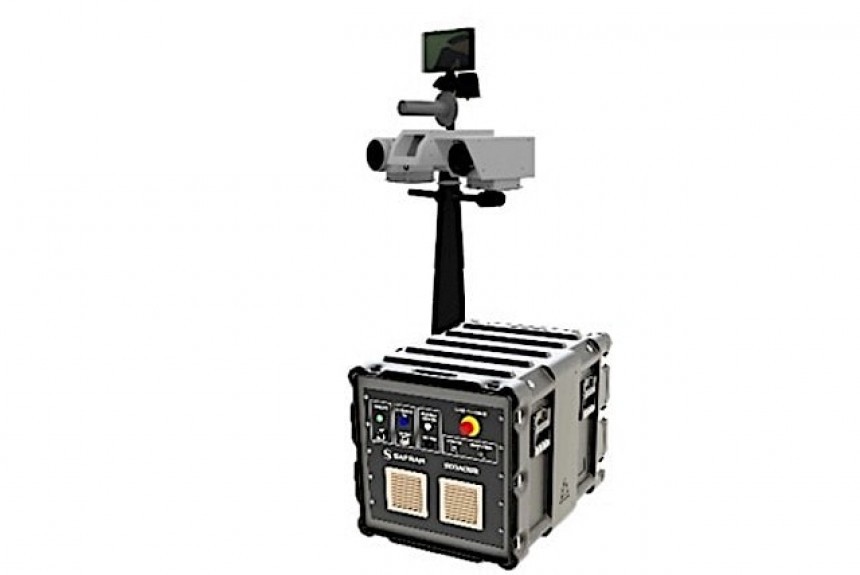There was a time a couple of decades ago when the world realized the future of warfare would be dominated by drones. But the world believed back then they would come in the form of bulky, aircraft-like contraptions that were controlled from afar. Instead, as the war in Ukraine has shown, we're now faced with swarms of small drones the likes of the FPVs that have the potential to do a lot more collective harm than combat drones.
If you really think about it, drones as weapons have evolved much faster than the means to fight them. In a relatively short period of time they have come to dominate the battlefields to such an extent that almost nothing, not even tanks, can stand in their way.
Those at the receiving end of drone warfare have tried to come up with various solutions to this problem, from using makeshift hardware protection for their vehicles to deploying rather ineffective jamming solutions. It seems, however, that the defense industry is slowly catching up, and more and more effective solutions come to light.
Last week the French capital Paris hosted what is the world's largest land and air defense industry fair, Eurosatory. The event was perfect for contractors from around the world to showcase their latest in defense technology. And it is there where an invisible drone killer was presented by French company Safran.
The technology is called Skyjacker, and I say it's invisible for two reasons. First, it operates far from where the action is actually taking place. Secondly, it's effects are so subtle enemy drone operators won't be able to tell something is wrong until it's too late.
The counter-drone solution is described by its maker as an "effective response to the growing threat posed by drones in the battlespace and at sensitive installations." It relies on spoofing, which is the act of convincing someone or something that data coming from an unknown source can be trusted, to confuse the drones to such an extent that they fail in their mission. The tech used is, according to Safran, something no other counter-drone system has at the moment.
Skyjacker works by simulating the GNSS signals that guide a drone to its target, replacing its original satellite guidance signals with modified ones. The new data tells the drone it's not actually where it should be, sending it on a wild goose chase on an altered trajectory and effectively making it unable to complete its mission.
Safran imagined this thing to work in conjunction with radar detection and optronic identification, and it can be used with equal success against both isolated drones and swarms of them coming after a target in saturation attacks. It can be used to protect both land and naval assets as well.
When fielded against singular drones that are remotely piloted, the Skyjacker can stop the flying menace from a distance of between one and six miles (one to 10 km). When countering swarms, it can work in conjunction with radiofrequency detectors, with lasers, communication jammers, and other effectors used to combat such threats.
From a hardware point of view, the technology is modular in design (sadly, there are not many official images of it for us to form a complete picture). It comprises a command and control unit, and one or more spoofing transmitters.
Depending on needs, the system can be used as a mobile unit, or it can be tied into existing surveillance environments, or into the fire control systems on board land vehicles and ships.
Although the Eurosatory fair was the first time the world got to meet the Skyjacker, Safran has been at it testing the solution for a while now. For instance, in March, the company deployed it during the Coubertin LAD II exercise that took place under the watchful eye of the Air and Space Force's Air Defense and Air Operations Command (CDAOA) at the Air Base 107 in Vélizy-Villacoublay, close to Paris.
Separately, trials with the French Navy have been ongoing for a while now, and they've proved “particularly conclusive […] as a highly effective, cost-controlled protection solution for frontline vessels."
An important test for the Skyjacker, if you will, are the upcoming Paris 2024 Summer Olympic Games, scheduled to kick off on July 26. Some 15,000 athletes and an estimated half a million spectators will have to be kept safe, including from unforeseen drone threats, and the Safran technology is scheduled to play its part.
Not many details were provided on when and where the Skyjacker will be deployed, but Safran it is working with the designer of the Bassalt anti-drone system, in use with the French Air and Space Force, to help shield innocents from harm.
Prior to the start of the Olympics, Skyjacker will also be used during the Bastille Day parade on July 14.
Those at the receiving end of drone warfare have tried to come up with various solutions to this problem, from using makeshift hardware protection for their vehicles to deploying rather ineffective jamming solutions. It seems, however, that the defense industry is slowly catching up, and more and more effective solutions come to light.
Last week the French capital Paris hosted what is the world's largest land and air defense industry fair, Eurosatory. The event was perfect for contractors from around the world to showcase their latest in defense technology. And it is there where an invisible drone killer was presented by French company Safran.
The technology is called Skyjacker, and I say it's invisible for two reasons. First, it operates far from where the action is actually taking place. Secondly, it's effects are so subtle enemy drone operators won't be able to tell something is wrong until it's too late.
Skyjacker works by simulating the GNSS signals that guide a drone to its target, replacing its original satellite guidance signals with modified ones. The new data tells the drone it's not actually where it should be, sending it on a wild goose chase on an altered trajectory and effectively making it unable to complete its mission.
Safran imagined this thing to work in conjunction with radar detection and optronic identification, and it can be used with equal success against both isolated drones and swarms of them coming after a target in saturation attacks. It can be used to protect both land and naval assets as well.
When fielded against singular drones that are remotely piloted, the Skyjacker can stop the flying menace from a distance of between one and six miles (one to 10 km). When countering swarms, it can work in conjunction with radiofrequency detectors, with lasers, communication jammers, and other effectors used to combat such threats.
From a hardware point of view, the technology is modular in design (sadly, there are not many official images of it for us to form a complete picture). It comprises a command and control unit, and one or more spoofing transmitters.
Although the Eurosatory fair was the first time the world got to meet the Skyjacker, Safran has been at it testing the solution for a while now. For instance, in March, the company deployed it during the Coubertin LAD II exercise that took place under the watchful eye of the Air and Space Force's Air Defense and Air Operations Command (CDAOA) at the Air Base 107 in Vélizy-Villacoublay, close to Paris.
Separately, trials with the French Navy have been ongoing for a while now, and they've proved “particularly conclusive […] as a highly effective, cost-controlled protection solution for frontline vessels."
An important test for the Skyjacker, if you will, are the upcoming Paris 2024 Summer Olympic Games, scheduled to kick off on July 26. Some 15,000 athletes and an estimated half a million spectators will have to be kept safe, including from unforeseen drone threats, and the Safran technology is scheduled to play its part.
Not many details were provided on when and where the Skyjacker will be deployed, but Safran it is working with the designer of the Bassalt anti-drone system, in use with the French Air and Space Force, to help shield innocents from harm.
Prior to the start of the Olympics, Skyjacker will also be used during the Bastille Day parade on July 14.










